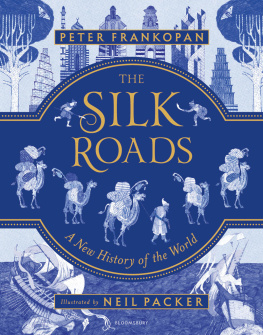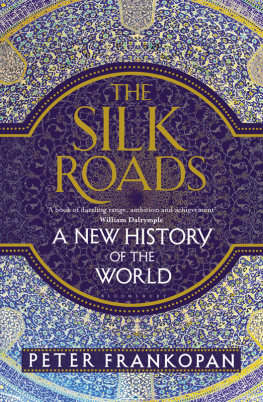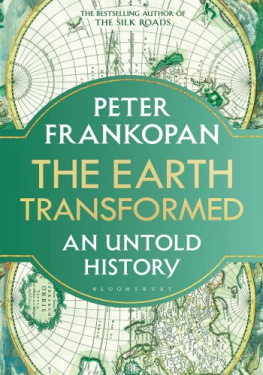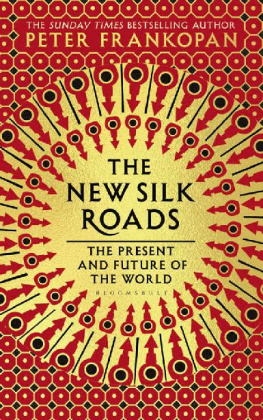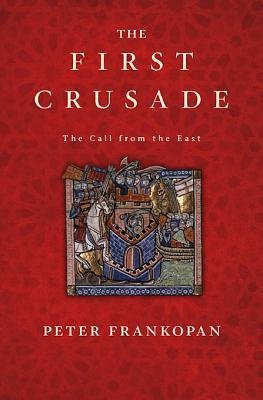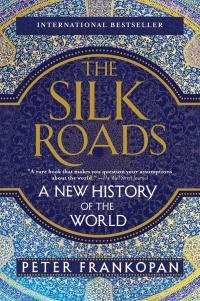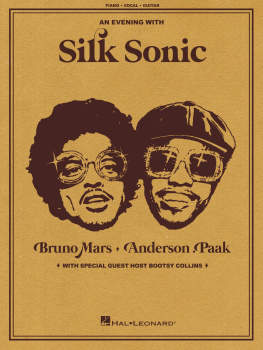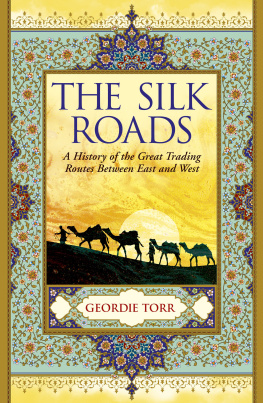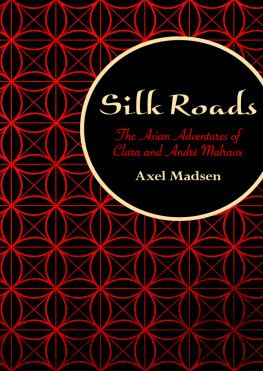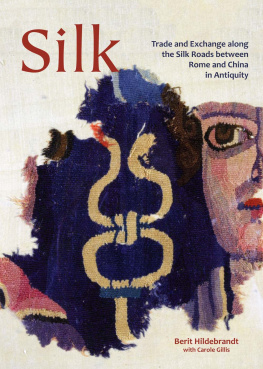Peter Frankopan - The Silk Roads
Here you can read online Peter Frankopan - The Silk Roads full text of the book (entire story) in english for free. Download pdf and epub, get meaning, cover and reviews about this ebook. year: 2018, publisher: Bloomsbury Publishing, genre: History. Description of the work, (preface) as well as reviews are available. Best literature library LitArk.com created for fans of good reading and offers a wide selection of genres:
Romance novel
Science fiction
Adventure
Detective
Science
History
Home and family
Prose
Art
Politics
Computer
Non-fiction
Religion
Business
Children
Humor
Choose a favorite category and find really read worthwhile books. Enjoy immersion in the world of imagination, feel the emotions of the characters or learn something new for yourself, make an fascinating discovery.
- Book:The Silk Roads
- Author:
- Publisher:Bloomsbury Publishing
- Genre:
- Year:2018
- Rating:3 / 5
- Favourites:Add to favourites
- Your mark:
- 60
- 1
- 2
- 3
- 4
- 5
The Silk Roads: summary, description and annotation
We offer to read an annotation, description, summary or preface (depends on what the author of the book "The Silk Roads" wrote himself). If you haven't found the necessary information about the book — write in the comments, we will try to find it.
The Silk Roads — read online for free the complete book (whole text) full work
Below is the text of the book, divided by pages. System saving the place of the last page read, allows you to conveniently read the book "The Silk Roads" online for free, without having to search again every time where you left off. Put a bookmark, and you can go to the page where you finished reading at any time.
Font size:
Interval:
Bookmark:


To my beloved Katarina, Flora, Francis and Luke
P. F.
For Judy and John, my parents
N. P.


Contents

The World Today
Maps are wonderful ways to help us think about the world. This is a map of the world in the early 21st century. It does not tell us much about what people think of each other or what is going on in the world but you can still learn a lot by studying it, and considering why we know so much more about some parts of the world than others.
Introduction

When I was a boy, I had a map on my bedroom wall. I used to stare at it when I woke up in the morning and before bedtime, admiring the size of the continents and the oceans, looking at the location of the mountain ranges, deserts and rivers, and trying to memorise the names of all the countries and their capital cities.
At school, I learned a lot about the history and geography of the country and continent where I lived. I loved learning about Britain and about Europe. But when I spoke with my parents, it was often about things elsewhere that I felt I should know about. In many parts of the world, people were fighting each other and I could not understand why. Places were changing, sometimes in a way that was good and sometimes in a way that was bad. When I listened to the news, I realised that millions of peoples lives would be affected either way.

We study history to understand the past, but also to try to help explain the present. History is a bit like tracing back your footsteps and trying to work out how and why you took a particular route to where you are now standing. It is interesting and exciting to look at individual turns or steps you made, but it can also be revealing to look at the journey as a whole.
Staring at the map on my wall, I wanted to learn about Russia, whose leaders at that time built nuclear weapons that were pointed directly at targets very close to where I went to school. I wanted to learn about the Middle East, where there seemed to be terrorist acts taking place almost every day, but which I also realised was the birthplace of lots of religions. I wanted to find out about China, Iran, India, Pakistan and Southeast Asia places that were not just the size of empires but had dominated the past and seemed to be enormously important in the modern world too. I longed to learn about the people, history, geography and culture of Africa and to understand if there were similarities and differences between one part of the continent and another.
I never got the chance to do that at school. Instead, I was taught a lot about Henry VIII and his six wives (divorced, beheaded, died, divorced, beheaded, survived in that order). I wish Id had a book that could have told me about all the other places. I wanted to understand how everything fitted together. Why, for example, was there nothing worth studying in between the Romans arriving in Britain and the Battle of Hastings a thousand years later?
And so I decided to spend my life reading and writing about history and looking for connections that would help explain the past better than how I had been taught as a child. I have had lots of help from scholars and writers, many of whom lived hundreds and in some cases thousands of years ago. One very important person was called Ferdinand von Richthofen (his nephew became a famous First World War fighter pilot, known as the Red Baron). He thought long and hard about how to come up with a name to describe the way that Asia, Europe and Africa are connected. He could have chosen the name of any of the goods and commodities that were transported over thousands of miles like spices or ceramics; he might even have chosen something to do with languages, travel or biology. But he decided on something that caught the imagination of other scholars something that has stuck to this day: the Silk Roads.

The Silk Roads do not have a start or an end point, because they are not actually real roads at all. They are a web of networks that have allowed goods, people and ideas, but also disease and violence, to flow east to west and west to east from the Pacific coast of China and Russia to the Atlantic coasts of Europe and Africa, and also from Scandinavia in the north to the Indian Ocean in the south. You might even think of the Silk Roads as the worlds central nervous system, linking all the organs of the body together, or perhaps as veins and arteries pumping oxygen and carbon dioxide away from and towards the heart. To understand the body, you need to look under the skin, and you also need to see how the body as a whole works, rather than just looking at one part of it.
In this book, we are going to visit places you might not have heard of before. Some have disappeared and are now gone: Merv, in modern Turkmenistan, was once so large and so beautiful that it was called the mother of the world. The magnificent city was destroyed by fighting 800 years ago, and never recovered.
Some places have changed. Today, Kabul is known as the capital of war-torn Afghanistan. But 500 years ago, the city had gardens that were famous hundreds of miles away. Mosul, in Iraq, is a city that was recently devastated by ISIS, who inflicted terrible suffering on the inhabitants, whom they used as human shields. However around 1,000 years ago, it was famous for its magnificent public buildings, its bathhouses and its craftsmen who produced some of the finest arrows, saddles and stirrups in the world.
Kabul is known as the capital of war-torn Afghanistan. But 500 years ago, the city had gardens that were famous hundreds of miles away
Some people will tell you that we are living through difficult times. It might feel that way sometimes. But the truth is that this is the best time to be alive ever. Travel has never been easier: you can get from one side of the world to another more quickly than any of your ancestors could. There have been astonishing improvements in health, for example with the survival rates of mothers and newborn babies rising dramatically in recent decades, or with the number of people who have access to clean water.

These improvements mean that children all over the world have better prospects than their parents and grandparents or any of their ancestors of surviving childhood and growing up healthy.
The chances of children being able to read and write are also now greater than at any time in the past. We can find things out faster and more cheaply than any generation before us in human history. We have extraordinary freedom to move, to learn and to live. It might not feel like you have superpowers. But you really do.
Font size:
Interval:
Bookmark:
Similar books «The Silk Roads»
Look at similar books to The Silk Roads. We have selected literature similar in name and meaning in the hope of providing readers with more options to find new, interesting, not yet read works.
Discussion, reviews of the book The Silk Roads and just readers' own opinions. Leave your comments, write what you think about the work, its meaning or the main characters. Specify what exactly you liked and what you didn't like, and why you think so.

